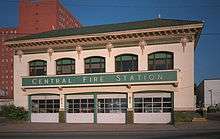History of Shreveport, Louisiana

| History of Louisiana |
|---|
|
|
|
Shreveport, Louisiana, was founded in 1836 by the Shreve Town Company, a development corporation established to start a town at the meeting point of the Red River and the Texas Trail. The Red River was cleared and made newly navigable by Captain Henry Miller Shreve, who commanded the United States Army Corps of Engineers. A 180-mile (289 km) long natural logjam, the Great Raft, had previously obstructed passage to shipping. Shreve used his specially-modified riverboat the Heliopolis to remove the logjam. The company and the village of Shreve Town were named in Shreve's honor.
Shreve Town was originally contained within the boundaries of a section of land sold to the company by the indigenous Caddo Indians in the year of 1835.[1] In 1838, Caddo Parish was created from the large Natchitoches Parish (pronounced "NACK-a-dish") and Shreve Town became the parish seat. Shreveport remains the parish seat of Caddo Parish today. On March 20, 1839, the town was incorporated as "Shreveport".[1] Originally, the town consisted of 64 city blocks, created by eight streets running west from the Red River and eight streets running south from Cross Bayou, one of its tributaries.
Shreveport soon became a center of steamboat commerce, mostly cotton and agricultural crops. Shreveport also had a slave market, though slave trading was not as widespread as in other parts of the state. Both slaves and freedmen worked on the river steamboats which plied the Red River, and as stevedores loading and unloading cargo. By 1860, Shreveport had a free population of 2,200 and 1,300 slaves within the city limits.
During the Civil War, Shreveport was a Confederate stronghold and the headquarters of the Trans-Mississippi Department of the Confederate Army. Isolated from events in the east, the Civil War continued in the Trans-Mississippi theater for several months after Robert E. Lee's surrender in April 1865, and Shreveport briefly became the Confederate capital. Confederate President Jefferson Davis attempted to flee to Shreveport when he left Richmond.

Shreveport and Bossier City have six historic districts and numerous NR listed landmarks. The original 64-block town is today the city's central business district and is listed on the National Register of Historic Places. Shreveport is second only to New Orleans among Louisiana cities in the number of historic landmarks. The McNeill Street Pumping Station is an 1887 waterworks that is still in use.
Barksdale Air Force Base, which opened in 1933 as Barksdale Army Air Field, is in Bossier City. It came into national attention when President George W. Bush was taken there during the September 11, 2001 attacks. It also came into national attention when B-52 bombers based there participated in Operation Enduring Freedom in Afghanistan and Operation Iraqi Freedom. Their attacks on fixed hard targets and the famed Iraqi Republican Guard Medina Division using state of the art JDAMs and other munitions marked a new era in U.S. air power where precision guided munitions were used more than "dumb" bombs with devastating effect (see Shock and Awe).
The Red River, opened by Shreve in the 1830s, remained navigable until 1914 when disuse, owing to the rise of the railroad as the preferred means of transporting goods and people, allowed it to begin silting up. Not until the 1990s was navigation of the river again possible to Shreveport. Today the port of Shreveport-Bossier City is being developed once again as a shipping center.
Shreveport's most famous musician, blues guitarist and singer Huddie William Leadbetter, a.k.a. 'Lead Belly', who inspired the folk and blues revivals of the Fifties and Sixties, was born January 15, 1888, on the Jeter Plantation near Shreveport. Leadbelly frequently performed in Shreveport's red light district, St. Paul's Bottoms, and after his death in 1949 while on tour in Europe, was buried in the community of Mooringsport, just north of Shreveport.
One of the city's most prominent downtown businessmen was the Missouri-born banker Peter Youree (1843–1914), who financed the ten-story Commercial National Bank Building (1910) and the Washington Youree Hotel. Youree's bank structure was the city's original skyscraper. Youree Drive in Shreveport bears his name.

Shreveport was also home to the Louisiana Hayride, a radio broadcast from the city's Municipal Auditorium that, during its heyday from 1948 to 1960, spawned the careers of some of the greatest names in American music, such as Hank Williams, Sr., and Elvis Presley (who got his start at this venue).[2]
The coming of riverboat gambling in the mid 1990s spurred a revitalization of the downtown and riverfront areas. Many downtown streets were given a facelift through the "Streetscape" project, where brick sidewalks and crosswalks were built and various artistic statues, sculptures, and mosaics were added. Also, the Texas Street Bridge was lit up with controversial neon lights, originally accompanied by a green laser beam which was eventually abandoned.
See also
References
- 1 2 Plummer, Marguerite R. & Joiner, Gary D. (2000). Historic Shreveport-Bossier: An Illustrated History of Shreveport and Bossier City, pp. 11-12. Historical Publishing Network.
- ↑ Aswell, Tom (2010). Louisiana Rocks!: The True Genesis of Rock & Roll, p. 261. Pelican Publishing Company, Inc.